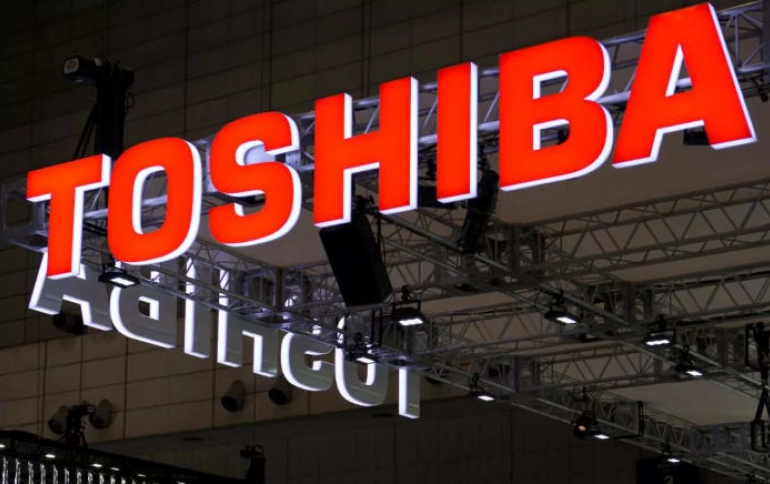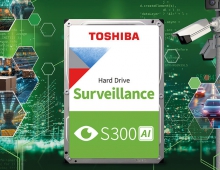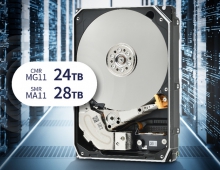
Toshiba Develops Accelerates Embedded NAND With New Controller
Toshiba has developed the world's fastest device controller for embedded NAND flash memory modules compliant with JEDEC's Universal Flash Storage (UFS) Ver.2.0 and UFS Unified Memory Extension (UME) Ver.1.0.
An embedded NAND flash memory module integrating the controller achieves a random read performance about 10 times faster than modules compliant with the e·MMC standard now widely used in low- to high-end mobile devices. Toshiba says that the new controller secures a performance equivalent to that of Solid State Drives (SSDs) for personal computers in a package as small as a fingernail.
Current embedded NAND flash memory modules are increasingly unable to store all the data required to execute commands received from the host in the on-chip RAM of their device controllers, largely because of its increasing size; the device controllers have to execute multiple reads of the command data from NAND flash memory, which slows command execution. The result is growing demand for improved random read performance. However, it is difficult to secure anything more than incremental improvement in random read performance, because it takes 10s of microseconds to read data from NAND flash memory.
Toshiba says that its ew device controller for embedded NAND flash memory module overcomes these issues.
The new device controller stores data for executing a command received from the host in the host-side DRAM, reducing the number of read operations from NAND flash memory. This halves the time required to process a read command. The procedure by which the device controller writes data to the host-side DRAM and reads data from host-side DRAM is compliant with the UFS UME Ver.1.0 standard, published at the same time as UFS Ver.2.0.
Toshiba has also developed a hardware engine that executes read commands received from the host in parallel and integrated it into the new device controller. It achieves more than two times higher random read performance compared with conventional technology.
These two new Toshiba technologies contribute to an embedded NAND flash memory module with a device controller that attains over 60 kIOPS in random read performance of 4 KB access. This performance level is about 10 times higher than that of modules compliant with e·MMC Version 5.0.
The new device controller also integrates a Toshiba-designed analog circuit technology that enables UFS's ultra-high-speed serial communication at 5.8Gbps per lane, keeping the power consumption low.
Toshiba will start shipping amples of embedded NAND flash memory modules with the new device controller in the first half of CY2014.
New Healthcare Business Strategy
Seperately, Hisao Tanaka, President and CEO, Toshiba Corp. has has introduced a new strategy for the Japanese company, that will establish its healthcare business as a third main pillar of operations, along with its energy and storage businesses.
Toshiba's boss said that the core of the strategy is to develop four business areas, prevention, diagnosis and treatment, prognosis and nursing care and health promotion, with the aim of achieving 600 billion yen in sales in fiscal year 2015.
Diagnosis and treatment is an already tried and tested business that includes such diagnostic imaging equipment as computed tomography systems. Toshiba will now cultivate prevention, which includes reducing the risk of ill by monitoring and predicting individual health; prognosis and nursing care, which will offer services that reduce burdens on families and other caregivers, and help patients to continue to live at home; and health promotion, which will seek to develop safer living environments and support for mental and physical health, so as to help people to continue to lead happy lives.
Current embedded NAND flash memory modules are increasingly unable to store all the data required to execute commands received from the host in the on-chip RAM of their device controllers, largely because of its increasing size; the device controllers have to execute multiple reads of the command data from NAND flash memory, which slows command execution. The result is growing demand for improved random read performance. However, it is difficult to secure anything more than incremental improvement in random read performance, because it takes 10s of microseconds to read data from NAND flash memory.
Toshiba says that its ew device controller for embedded NAND flash memory module overcomes these issues.
The new device controller stores data for executing a command received from the host in the host-side DRAM, reducing the number of read operations from NAND flash memory. This halves the time required to process a read command. The procedure by which the device controller writes data to the host-side DRAM and reads data from host-side DRAM is compliant with the UFS UME Ver.1.0 standard, published at the same time as UFS Ver.2.0.
Toshiba has also developed a hardware engine that executes read commands received from the host in parallel and integrated it into the new device controller. It achieves more than two times higher random read performance compared with conventional technology.
These two new Toshiba technologies contribute to an embedded NAND flash memory module with a device controller that attains over 60 kIOPS in random read performance of 4 KB access. This performance level is about 10 times higher than that of modules compliant with e·MMC Version 5.0.
The new device controller also integrates a Toshiba-designed analog circuit technology that enables UFS's ultra-high-speed serial communication at 5.8Gbps per lane, keeping the power consumption low.
Toshiba will start shipping amples of embedded NAND flash memory modules with the new device controller in the first half of CY2014.
New Healthcare Business Strategy
Seperately, Hisao Tanaka, President and CEO, Toshiba Corp. has has introduced a new strategy for the Japanese company, that will establish its healthcare business as a third main pillar of operations, along with its energy and storage businesses.
Toshiba's boss said that the core of the strategy is to develop four business areas, prevention, diagnosis and treatment, prognosis and nursing care and health promotion, with the aim of achieving 600 billion yen in sales in fiscal year 2015.
Diagnosis and treatment is an already tried and tested business that includes such diagnostic imaging equipment as computed tomography systems. Toshiba will now cultivate prevention, which includes reducing the risk of ill by monitoring and predicting individual health; prognosis and nursing care, which will offer services that reduce burdens on families and other caregivers, and help patients to continue to live at home; and health promotion, which will seek to develop safer living environments and support for mental and physical health, so as to help people to continue to lead happy lives.





















